13+ SAMPLE Executive Compensation Proposal
-
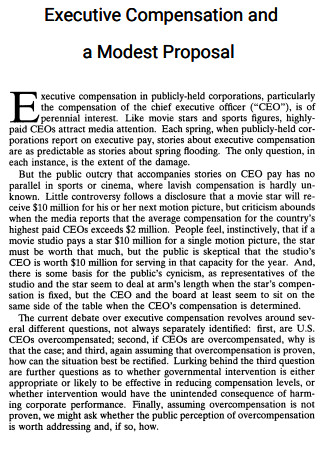
Executive Compensation and Modest Proposal
download now -
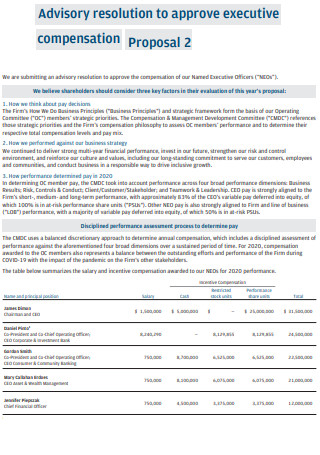
Advisory Executive Compensation Proposal
download now -
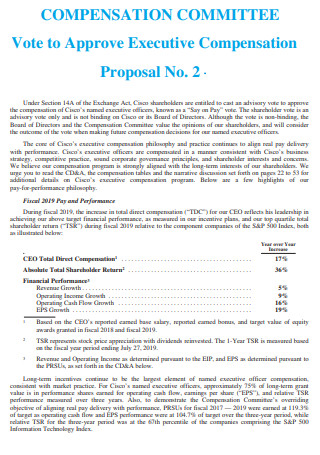
Executive Compensation Commitee Proposal
download now -
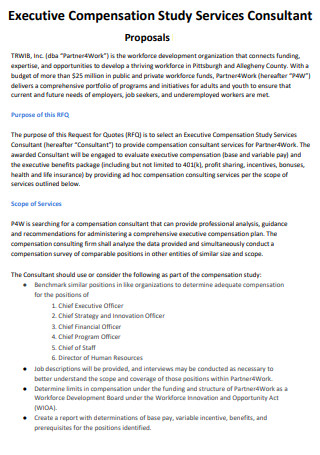
Executive Compensation Study Proposal
download now -

Executive Compensation Proposal
download now -
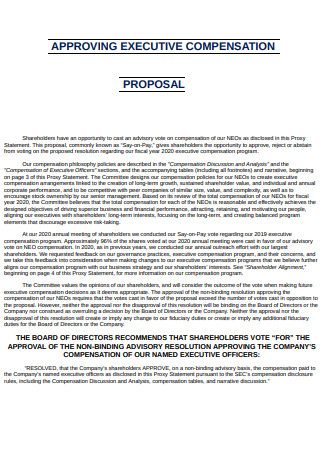
Approving Executive Compensation Proposal
download now -
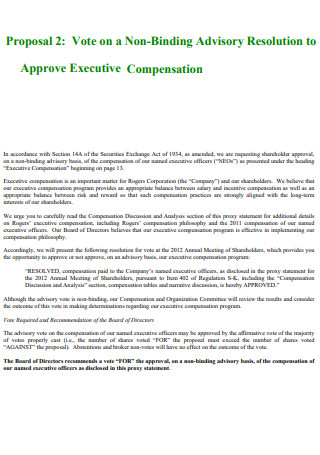
Non Binding Executive Compensation Proposal
download now -
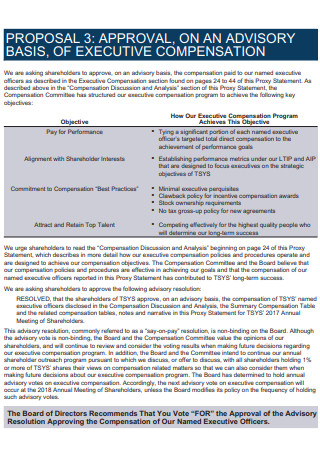
Sample Executive Compensation Proposal
download now -
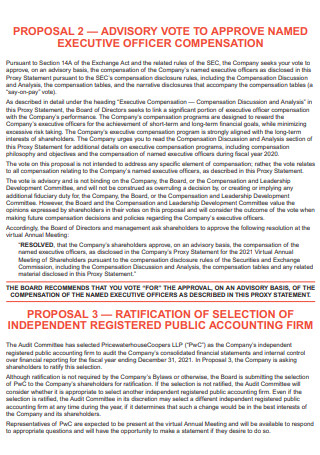
Executive Officer Compensation Proposal
download now -
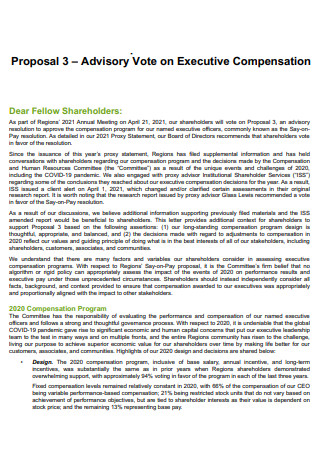
Advisory Vote Executive Compensation Proposal
download now -
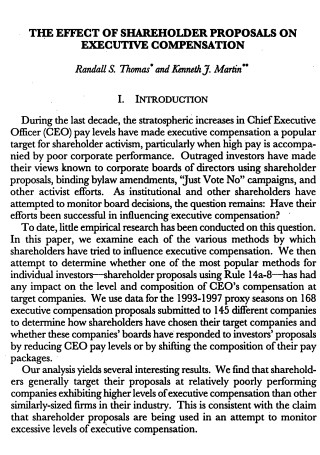
Shareholder Proposals On Executive Compensation
download now -

Executive Compensation Management Proposal
download now -
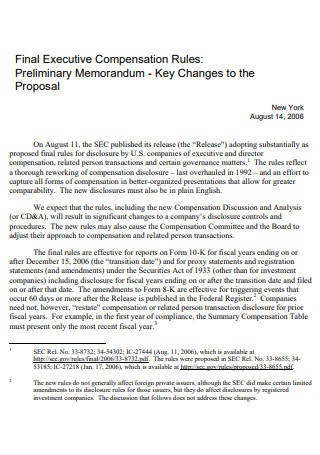
Final Executive Compensation Proposal
download now -

Basic Executive Compensation Proposal
download now
FREE Executive Compensation Proposal s to Download
13+ SAMPLE Executive Compensation Proposal
What Is an Executive Compensation Proposal?
What Is Typically Included in an Executive Compensation Package?
Types of Compensation Package
How to Develop an Executive Compensation Proposal
FAQs
What is direct compensation?
What is the importance of executive compensation?
What is indirect compensation?
What Is an Executive Compensation Proposal?
First of all, what is executive compensation? By definition, this refers to pay packages established specifically for a company’s business executives, senior management, and executive-level personnel. It is often a combination of a fixed wage, adjustable performance-based incentives such as money, shares, bonuses, and any other perquisites, all of which are optimally set to take into consideration government rules, tax law, and the executive’s and the organization’s preferences. Having a proper compensation proposal also weighs heavily on company shareholders, since executives who are inappropriately rewarded may lack the motivation to work in the best interests of shareholders, which can be detrimental for those shareholders.
An executive compensation proposal is a business document that is sent by executive staff to their employers when they want to negotiate a higher or new salary. This paper is critical in pay negotiations since it is the first step in seeking a higher wage. This form of documentation is usually preferred over approaching your employer in person since it allows him or her time to assess the request without putting him or her on the spot. If the proposal is approved, the executive in question would earn increased executive compensation, which may inspire them to work more and make better judgments for the future of the company.
What Is Typically Included in an Executive Compensation Package?
Here are the typical elements that you see in an executive compensation package (or any type of compensation package, for that matter):
Types of Compensation Package
Now that the components of an executive compensation package have been discussed, it’s time to elaborate on some of the different types of compensation packages:
How to Develop an Executive Compensation Proposal
Now that we’ve discussed what’s inside a compensation proposal and its different types, it’s time to learn the steps on how to develop this proposal. It may be a lengthy and complex process but by following these steps, you can be sure that you’ve done it right.
1. Define Its Purpose
The first major step in creating an executive compensation proposal (apart from introducing yourself) is to define the purpose of this document. In properly defining the purpose of the proposal, you may start with a cordial introduction and be polite in your writing. You should also mention everything that you’ve accomplished so far which serves to demonstrate that you, as an executive employee, deserve an increase in compensation. Additionally, make your employers aware of the research you’ve done concerning industry standards on compensation. The research you’ve done must include the typical market conditions similar to your position and the compensation that they’re getting at your level.
2. State Your Expectations
After writing the introductory part of your proposal, proceed to this step. Describe your expectations from the company. In this step, you may declare that you desire an improvement in your compensation package, an increase in your yearly performance bonus, additional perks, and a bigger sales commission. The main thing to remember here is to communicate explicitly what you expect from the organization. In a nutshell, you must be direct. If your proposal explicitly states what you want, such as a raise in pay, it will have a greater impact than writing extensive dissertations in the letter.
3. State What You Need
After stating what you expect from the company with regards to your compensation package, proceed to this step. Simply citing the rise in sales will not help you. You must state explicitly in this step of developing the proposal what your specific amount for the wage increase is. If there is a percentage increase in compensation, make it apparent by comparing it to the gain in the value of the industry you work in. You must also write in a professional manner that your performance in the company justifies the outcomes that are being witnessed, and that you desire and deserve a rise of a particular percentage in your annual income.
4. Set Some Alternatives
During the negotiation phase, sometimes it can get difficult for the company to cater to exactly what you need, so this step is important. Sometimes it is impossible for the corporation to accommodate your expectations, therefore you will have to give alternatives such as a rise in all the other additional benefits and so on. If you do not want to withdraw totally from the discussions, you might demand an increase in alternative forms of compensation other than your basic salary, such as additional perks, and so on. Aside from that, it may include education perks, daycare, pension plans, health insurance, and sick days, among other things.
5. Negotiate and Present the Proposal
After stating explicitly the percentage of salary increase that you need and deserve and setting some alternative options, it’s time to negotiate this with your employer. Negotiating wages entails not only stating your beginning salary range from where you began, but also including certain other important information such as job requirements, qualifications, years of experience, location and in which company you worked, and so on. Furthermore, you should begin by stating figures from the lowest to the greatest number. If you include any numerical figures, make sure they are right otherwise you may get in trouble. If the statistics given are incorrect and things go awry in this process, it will have an impact on the reputation that you have in your company.
6. Submit on the Right Time
One thing to keep in mind is that it is also important to submit your proposal at the right time. Timing must also be taken into account when developing a compensation plan. This is due to the fact that you will never know what the corporation is going through. Perhaps the firm is experiencing a financial imbalance and is unable to give you the additional raise in compensation, or perhaps it is the busiest time of the year and the manager is too busy to refer to your proposal and evaluate your request for an increase.
FAQs
What is direct compensation?
Direct compensation is money that is paid directly to employees in return for their labor. Wages, salaries, bonuses, gratuities, and commissions are examples of direct remuneration. It is often the most well-known form of compensation, and it is likely the first sort of compensation requested by the majority of workers.
What is the importance of executive compensation?
A remuneration plan for executives may inspire them to work hard and make the greatest business choices for the future of the company. They may be encouraged to do so because, in order to keep earning remuneration, the company must operate at peak efficiency. Company success may imply that it earns more money than the preceding year or outperforms its competitors. Appropriate CEO remuneration may also boost a firm’s long-term performance, profitable expansion, and other specific corporate goals.
What is indirect compensation?
Indirect financial compensation is compensation provided to an employee that has monetary worth but is not paid directly. It is also known as a non-cash benefit. They are also referred to as employee incentives or employee perks. In certain cases, these indirect compensations may prove to be more beneficial to an employee than a higher pay or income.
Company executives usually make the heaviest and the most impactful decisions that can decide the fate of the company that they work for, so it is only rightful that they deserve a very decent compensation package to reward them for their troubles and sacrifices. And having an equally competent compensation proposal for these executives is also important. When creating this document, it is only natural to run into some difficulties since this document can be really complex to make. In this article, there are plenty of sample templates for you to have a look at in case you find yourself in a difficult position when making this document.
